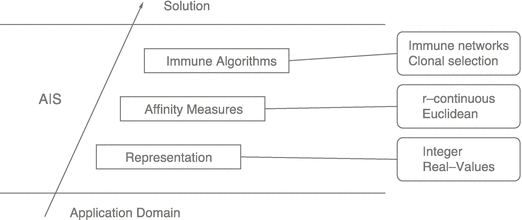Artificial Immune System
An Artificial Immune System is an Machine Learning System based on an Immune Network.
- AKA: Immune Computing; Immune-inspired Computing; Immunocomputing; Immunological Computation.
- Context:
- It implements an Artificial Immune System Algorithm to solve a Artificial Immune Sytem Task.
- …
- Example(s):
- Adaptive Immune System,
- an AiNet System such as:
- …
- Counter-Example(s):
- See: Immune Network, Neural Network, Machine Learning System.
References
2018
- (Wikipedia, 2018) ⇒ https://en.wikipedia.org/wiki/Artificial_immune_system Retrieved:2018-6-3.
- In artificial intelligence, artificial immune systems (AIS) are a class of computationally intelligent, rule-based machine learning systems inspired by the principles and processes of the vertebrate immune system. The algorithms are typically modeled after the immune system's characteristics of learning and memory for use in problem-solving.
2017
- (Timmis, 2017) ⇒ Jon Timmis.(2017). "Artificial Immune Systems". In: Sammut C., Webb G.I. (eds) Encyclopedia of Machine Learning and Data Mining. Springer, Boston, MA.
- Artificial immune systems (AIS) have emerged as a computational intelligence approach that shows great promise. Inspired by the complexity of the immune system, computer scientists and engineers have created systems that in some way mimic or capture certain computationally appealing properties of the immune system, with the aim of building more robust and adaptable solutions. AIS have been defined by de Castro and Timmis (2002) as:
- adaptive systems, inspired by theoretical immunology and observed immune functions, principle and models, which are applied to problem solving
- Artificial immune systems (AIS) have emerged as a computational intelligence approach that shows great promise. Inspired by the complexity of the immune system, computer scientists and engineers have created systems that in some way mimic or capture certain computationally appealing properties of the immune system, with the aim of building more robust and adaptable solutions. AIS have been defined by de Castro and Timmis (2002) as:
- AIS are not limited to machine learning systems, there are a wide variety of other areas in which AIS are developed such as optimization, scheduling, fault tolerance, and robotics (Hart and Timmis 2008). Within the context of machine learning, both supervised and unsupervised approaches have been developed. Immune-inspired learning approaches typically develop a memory set of detectors that are capable of classifying unseen data items (in the case of supervised learning) or a memory set of detectors that represent clusters within the data (in the case of unsupervised learning). Both static and dynamic learning systems have been developed (...)
2011
- (Timmis, 2011) ⇒ Jon Timmis. (2011). “Artificial Immune Systems.” In: (Sammut & Webb, 2011) p.41
2008
- (Hart and Timmis, 2008) ⇒ Emma Hart, Jon Timmis. (2008). "Application areas of AIS: the past, present and the future" (PDF). J Appl Soft Comput 8(1):191–201 https://doi.org/10.1016/j.asoc.2006.12.004
- QUOTE: In this position paper, we hope to extract some general features of problems that we believe will allow AIS to really bring some benefit, and thus distinguish it from other techniques. We suggest that the way forward for AIS is in part a focussed attempt to carefully select application areas based on mapping problem features to mechanisms exhibited by the IS, taking the problem-oriented perspective outlined by example in [73,32,13], and discussed further in Section 4.2. However, we emphasise that application development needs to be under-pinned with a continuing line of research into the theoretical basis of AIS and with the overriding need for extraction of novel and accurate metaphors from immunology(...)
2002
- (Castro and Timmis, 2002) ⇒ de Castro LN, Timmis J (2002) "Artificial immune systems: a new computational intelligence approach" (BOOK). Springer, New York.
- QUOTE: Artificial immune systems (AIS) are introduced and a framework to engineer them is proposed. The framework is based upon a set of general-purpose algorithms and models to create abstract (or artificial) components of the immune system. These derive from a number of significant works from the literature on AIS and theoretical immunology. The majority of these works were developed with a single application in mind. Here, these ideas have been taken and abstracted out to form basic models and algorithms based on immune components that can the used in a variety of application areas (...)
(...) In a recent work, de Castro and Timmis (2002) introduced AIS as a new soft computing paradigm. This work summarized the framework described in Chapter 3 and AIS were placed in context With other well-established soft computing approaches such as ANNs, EAs, and fuzzy systems (FS). Generally speaking, AIS, ANN, and EA have great potential to interact With each other in any direction, as suggested in Figure 6.18. Most of the works that try to integrate AIS with ANN and EA, involve artificial neural and immune network models, or immune and evolutionary algorithms. This section is an extended version of that paper and reviews these hybrid approaches focusing on how one strategy was used in order to improve the performance of the other.
- QUOTE: Artificial immune systems (AIS) are introduced and a framework to engineer them is proposed. The framework is based upon a set of general-purpose algorithms and models to create abstract (or artificial) components of the immune system. These derive from a number of significant works from the literature on AIS and theoretical immunology. The majority of these works were developed with a single application in mind. Here, these ideas have been taken and abstracted out to form basic models and algorithms based on immune components that can the used in a variety of application areas (...)



